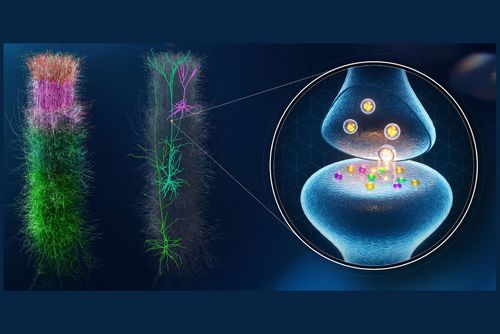Everyone knows that the human brain is very complex. But how exactly does he learn? Well, the answer may be much simpler than you think.
An international research team including the University of Montreal has achieved a major breakthrough by precisely simulating synaptic changes in the neocortex that are essential for learning, paving the way for a better understanding of brain function.
The scientists’ study – which relies on an open source model – was published 1Verse June in Nature Communications.
A world of new trends
“It opens up a world of new directions for scientific research into how we learn,” he said. Elif Muller،, Assistant Professor in the Department of Neurosciences at UdeM University, Researcher at Evado – Institute for Data Valuation – and holder of the CIFAR-Canada Chair in Artificial Intelligence (AI), who co-led the study on the Blue Brain project at the Ecole Polytechnique Polytechnique de Lausanne (EPFL), Switzerland.
Eilif Muller moved to Montreal in 2019 and continues his research in the lab Biological learning architectureswhich he founded at the CHU Sainte-Justine Research Center in collaboration with UdeM and Mila, the Quebec Institute for Artificial Intelligence.
“The neurons are shaped like a tree and the synapses are the leaves on the branches,” explained Professor Muller, co-lead author of the study. Previous approaches to modeling plasticity ignored this tree structure, but we now have the computational tools to test the idea that synaptic interactions on branches play an essential role in guiding learning in vivo. “
According to him, “This has important implications for understanding the mechanisms of neurodevelopmental disorders such as autism and schizophrenia, but also for developing powerful new approaches to AI inspired by neuroscience.”
Employees in five countries
Eilif Muller collaborated with a group of scientists from EPFL’s Blue Brain Project, University of Paris, Hebrew University of Jerusalem, Cajal Institute (Spain) and Harvard Medical School to develop a model of synaptic plasticity in the neocortex based on postsynaptic calcium dynamics under data constraints.
How it works? Simpler than you think.
The brain is made up of billions of neurons that communicate with each other by forming trillions of synapses. These contact points between neurons are complex molecular machines that are constantly changing under the influence of external stimuli and internal dynamics, a process commonly referred to as synaptic plasticity.
In the neocortex, a key area associated with the learning of high-level cognitive functions in mammals, pyramidal cells represent 80–90% of neurons and are known to play a major role in learning. Despite their importance, the long-term dynamics of their synaptic changes have been distinguished experimentally only among a few of their species and have been shown to be diverse.
limited understanding
Therefore, understanding of the complex neural circuits formed, particularly through the modular cortical layers, which dictate how different regions of the neocortex interact, is limited. Elif Muller and colleagues’ innovation was to use computer modeling to gain a more comprehensive view of the dynamics of synaptic plasticity that govern learning in these neocortical circuits.
By comparing their results with the available experimental data, they show in their study that their model of synaptic plasticity can explain the diverse plasticity dynamics of the different pyramidal cells that make up the neocortical microcircuit. They achieved this using a single, unified set of model parameters, indicating that the rules of modern cortical plasticity can be shared by all types of hierarchical cells and are thus predictable.
Most of these plasticity experiments were performed on rodent brain slices in vitro, in which the calcium dynamics governing synaptic transmission and plasticity were significantly altered compared to learning in the intact brain in vivo. Importantly, the study predicts plasticity dynamics that are qualitatively different from standard in vitro experiments.
If confirmed by future experiments, the implications for our understanding of flexibility and learning in the brain will be significant, Eilif Muller and his team believe.
“The exciting thing about this study is that it is further confirmation to scientists that we can overcome empirical knowledge gaps by using a modeling approach when studying the brain,” said the EPFL neuroscientist. Henry Markram, Founder and Director of the Blue Brain Project.
It’s an open science
Moreover, the model is open source, Available on Zenedo, he added. Here we have shared hundreds of plastic connections for pyramidal cells of different types. It is not only the most widely validated plasticity model to date, but it also represents the most comprehensive prediction of differences between plasticity seen in a petri dish and in a healthy brain. “
Henry Markram concluded by saying that “this leap in paradigm is made possible by our collaborative team-based approach to science. In addition, the community can go further and design their own versions by modifying or supplementing them. It is an open science and will accelerate progress.”
About this study
The study entitled “A calcium-based plasticity model for predicting long-term piety and depression in the neocortex”, by Giuseppe Chindimi and his collaborators, was published 1Verse June 2022 in Nature Communications. The Blue Brain project was funded by the Council of the Swiss Federal Institutes of Technology. Eilif Muller’s work has also been funded by the CHU Sainte-Justine Research Centre, IVADO – the Institute for the Valuation of Data -, the Quebec Research Fund – Health, the Canadian Chairs Program for Artificial Intelligence CIFAR, Mila – the Quebec Institute for Technical Intelligence – and Google.

“Proud thinker. Tv fanatic. Communicator. Evil student. Food junkie. Passionate coffee geek. Award-winning alcohol advocate.”


